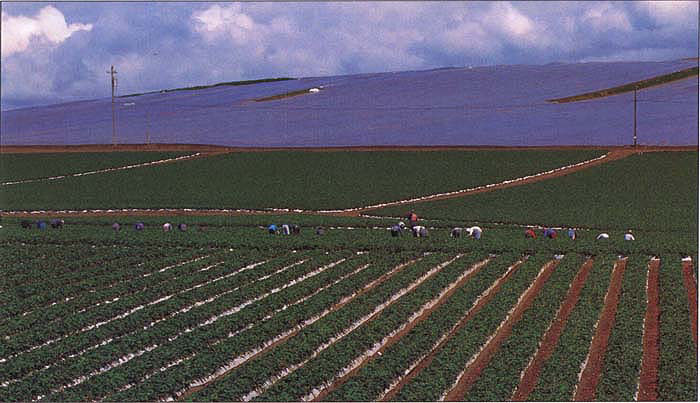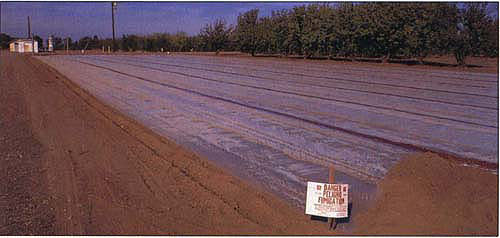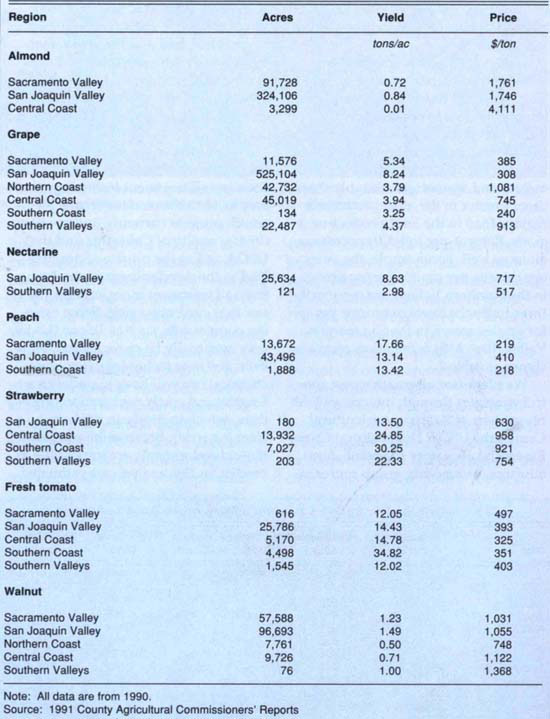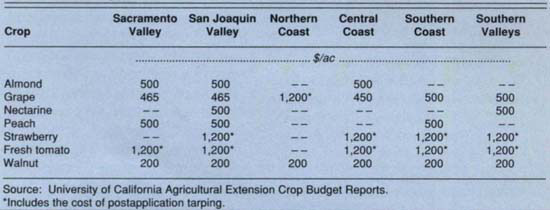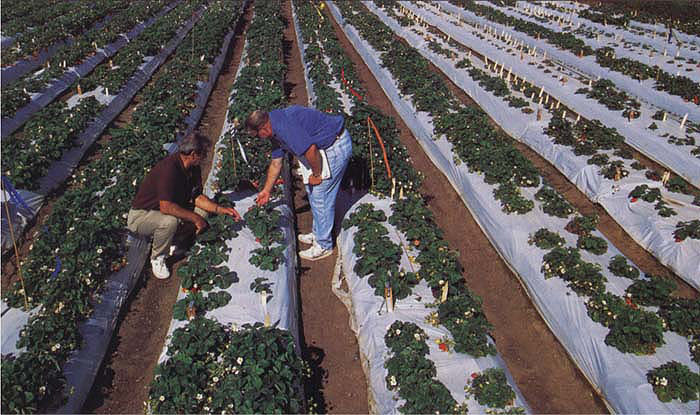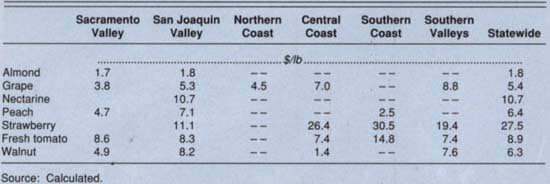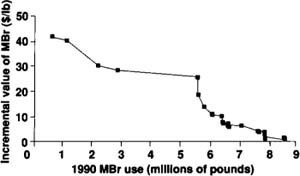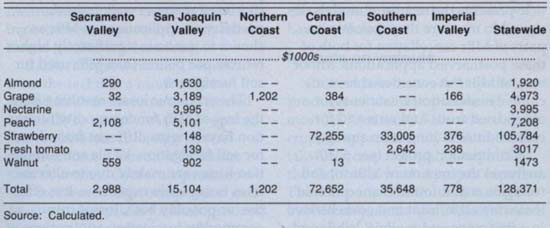All Issues
Methyl bromide regulation: All crops should not be treated equally
Publication Information
California Agriculture 48(3):10-15.
Published May 01, 1994
PDF | Citation | Permissions
Abstract
Over the next 7 years, all agricultural uses of methyl bromide (MBr) will be phased out, in compliance with mandates from the US. Environmental Protection Agency and the UN Environment Programmed. This compound has been widely applied as a soil fumigant, and its loss will be felt throughout the state, though more in some crops and regions than in others. Research shows that the heaviest economic loss will be sustained by strawberry growers in the Central and South Coast regions and by nursery operations statewide. A phase-out beginning with the low-value uses of MBr would avert some of the inefficiencies implied by canceling all agricultural uses at once.
Full text
Tarping and fumigating fields with methyl bromide to kill soil-borne pests and diseases before planting (as shown in the background) is a cornerstone of strawberry production. Strawberry growers in the Central and South Coast regions will suffer the heaviest economic loss from the methyl bromide ban.
Methyl bromide (MBr) is a highly volatile, extremely toxic broad-spectrum pesticide used in California agriculture to control pests on 60 different crops. Growers primarily apply MBr as a preplant soil fumigant targeting nematodes, fungi and other soil-borne organisms, as well as some weeds and insects. (Postharvest commodity fumigation with MBr, which accounts for 5% of total agricultural use, is discussed in the accompanying article, p. 16 .)
In response to public and worker concern about the health implications of agricultural reliance on MBr, the California Department of Pesticide Regulation has been developing stricter rules for controlling its use. Also, in response to recent findings that release of MBr into the atmosphere may contribute to degradation of the ozone layer, both the Environmental Protection Agency (EPA) and the United Nations Environment Programme (UNEP) initiated procedures to bring about national and worldwide reductions in MBr use by the year 2001. (The U.S. Congress passed legislation calling for a 100% ban nationwide by 2001; the United Nations has recommended a voluntary 25% reduction in MBr use worldwide.)
With the expected cancellation of MBr's registration for soil fumigation, California growers will be seeking alternative soil treatment strategies, and they will need to weigh the different costs and yield effects associated with each strategy. Our study was undertaken to measure the economic impact of losing MBr as a soil fumigant. We compared farm profitability under current pest control strategies, which include MBr, with projected farm profitability when farmers must choose a different soil treatment. The study also illustrates a modeling approach to impact assessment that combines region-specific agronomic and economic data in a consistent framework so that the economic implications of different policy options can be evaluated.
Calculating the net benefit of methyl bromide for perennial crops is more difficult because the physical and economic effects of cancelling methyl bromide may occur over the lifetime of the crop, which could be more than 30 years.
Our approach to pesticide benefit analysis emphasizes regional differences. Because of the diversity of soils, pests and economic conditions in California's producing regions, pesticides have different yield effects and cost characteristics depending on where they are used. Failure to take these regional variations into account can lead to significant bias in estimations of pesticide benefits.
At present, the MBr ban is scheduled to take effect in 2001 for all uses, regardless of wide variations in crop and regional impact, and irrespective of whether MBr alternatives exist. Our study indicates that there are MBr alternatives for a large number of crops, but not all. Theoretically, under an MBr ban, growers in each region would choose the alternative soil treatment technology that generated the highest profits given local conditions. By analyzing each crop and region separately, the approach we describe allows policy makers to identify specific high-value uses as well as particularly vulnerable growing regions. It may be possible to develop regulatory policies that achieve desired pesticide-reduction goals with the greatest efficiency and least loss to growers.
Impact on 6 regions
The impact of MBr cancellation is measured separately for each of the following California regions: the Sacramento Valley, San Joaquin Valley, Northern Coast, Central Coast, Southern Coast and Southern Valleys. In these regions, soil fumigation with MBr is currently widespread in three categories of crops: flowers, fruits and vegetables grown in nurseries; other high-value annuals; and perennials. We studied crops with the highest MBr use levels according to the Department of Pesticide Regulation's 1990 Pesticide Use Report. High-value annuals include all nursery crops, strawberries and fresh tomatoes. Perennials include almonds, grapes, peaches, nectarines and walnuts. Each of these crops is grown in at least two of the six growing regions in the state.
Table 1 shows how commodity yields and farm-gate prices vary by region. The importance of regional differences is clear in comparisons of yields and prices across regions for specific commodities. For example, per-acre yields for nectarines, fresh tomatoes and walnuts are roughly three times greater in the most productive regions than in the least productive regions. Returns per ton differ across regions as well. For example, the average returns per ton for grapes grown in the Southern Valleys are reportedly three times the average returns per ton for grapes grown in the San Joaquin Valley. Base MBr fumigation costs are shown in table 2.
We identified alternative pest control strategies through interviews with researchers at Kearney Agricultural Center, the USDA Horticultural Crops Research Laboratory in Fresno, farm advisors, commodity group representatives, chemical company representatives and growers. For each commodity in each region where it is grown, we developed a set of alternative soil treatment strategies, including expected costs and yield effects. Expected costs for chemical alternatives were assumed to be the same as their current market price, and growers were assumed to apply them at the rate specified on the label. Few field trials have compared yields from a MBr-based pest control strategy with those from alternative strategies; therefore, our estimates of yield effects reflect the educated best guesses of those in the field.
Among the alternative chemicals considered were metam sodium, fenamiphos, and an experimental application of highly concentrated urea or other nitrogen fertilizers. The nonchemical controls considered were crop rotation, fallowing and soil solarization.
We studied only the short-term impact of losing MBr, excluding innovations in soil treatment technology that may arise in the next few years. Research projects currently underway at the University of California and the USDA and in the private sector may lead to the development of an alternative soil treatment more suitable than any that currently exists. Some existing compounds, such as Telone (1,3-D), may eventually be re-registered. However, any new technology involving chemical use will have to undergo a lengthy and costly registration procedure, which in itself can prove to be a sizable barrier. Because the results of these developments are impossible to predict, in this analysis we estimated only short-term impacts given currently available technology.
Impact analysis
The first component of the model is an algorithm in which the highest profit alternative pest control technology for each commodity in each region is calculated, given expected cost and yield effects and holding farm-gate prices constant. Table 3 shows the results of these calculations. Blanks indicate that little if any acreage is devoted to a particular commodity in a given region. Metam sodium is the highest-profit alternative to MBr for all annuals and a number of perennials. In some instances, crop rotation is the highest-profit alternative; these cases are typically characterized by relatively low per-acre profits with MBr.
The results of this computation form the basis for calculating the incremental benefit to growers for each pound of MBr applied, relative to the highest-profit alternative. This measure is derived by comparing profits under current strategies, which include soil treatment with MBr, with expected profits under the most profitable alternative control strategy for each commodity and region. The implied value of 1 pound of MBr is then calculated as the difference in profits, divided by the number of pounds of MBr applied.
The second component of the model is the calculation of the net financial impact of MBr cancellation disaggregated by region and by commodity. The base yield and price per ton for each crop and region examined in the model is apparent from table 1. Table 4 shows the results of the calculations of net returns per pound of MBr applied, based on the preferred pest control alternative shown in table 3.
The values in Table 4 were calculated as follows. For annual crops, metam sodium is the highest profit alternative. According to data provided by the California Strawberry Advisory Board, this choice implies a cost increase of $520 per acre following MBr cancellation and a yield decrease of 20% due to the reduced spectrum of control achieved by metam sodium compared to MBr. The expected cost increase comes from substituting metam sodium for MBr, which will raise costs by $200 per acre, and doubling the use of chloropicrin, which will raise costs by $320 per acre. Prices are based on 1990 grower returns obtained from various County Agricultural Commissioners' reports.
Above, plant pathologists John Mircetich, left, and Doug Gubler are evaluating alternative soil treatments for strawberries. The right side of this field was not fumigated. The highest return per pound of methyl bromide is earned when it is used for strawberries.
The net benefit per pound of MBr applied for perennial crops is more difficult to calculate because the physical and economic effects of canceling MBr may occur over many years. The costs of producing perennial crops include those for planting (a significant up-front cost), culture (a relatively constant annual cost) and harvest (a function of yield). For example, if growers choose crop rotation to replace MBr, per-acre planting costs will drop because no soil fumigation is required. At the same time, without MBr, growers will no longer be able to spot-treat areas within existing orchards; consequently, roughly 5 to 10% fewer trees or vines will survive to maturity. The smaller number of trees or vines per acre implies both a drop in cultural costs and a decrease in harvest costs. Accompanying these cost decreases will be corresponding decreases in output, with the result that total profits per acre will fall. The prices used to calculate the net benefits of MBr use for perennials are from County Agricultural Commissioners' reports. Values are discounted by 4% so that future nominal profit changes can be expressed in current dollars. (This allows us to compare current returns for perennials such as walnuts to current returns for annuals such as strawberries.)
The diversity in per-pound net returns from MBr is apparent from table 4. The highest returns per pound are for strawberries, a fact that reflects this crop's high per-acre profit. The next highest per-pound value is for nectarines, followed by tomatoes, peaches, walnuts, grapes and almonds.
TABLE 3. Highest profit alternatives to soil fumigation with methyl bromide, perennial and annual crops
Table 5 shows net returns per pound from MBr use for nurseries. These returns vary significantly by application. In nurseries, it is especially difficult to determine the current costs and yields associated with MBr use as well as to project changes in those values when MBr is canceled. The nursery industry is very diverse, and the specificity and completeness of available nursery production data vary greatly across counties. Another problem is that nursery products for export must be certified as pest-free; soil fumigation with MBr is commonly an important tool for meeting this condition.
Cancellation of MBr will thus have two effects on costs: soil treatment costs will change, and harvest costs will fall due to yield losses or to voluntarily reduced production in response to the narrowed access to export markets. For cut flowers, growers are expected to adapt steam treatment for indoor production and dazomet for outdoor production. Increase in treatment costs outweighs the lower harvest cost resulting from reduced production. For rose plants, fruits, vines and nuts, and strawberry plants, growers are expected to substitute increased crop rotations for MBr. In this case, the lower harvest costs outweigh the change in soil treatment costs, so that cost per acre actually falls. On the other hand, grower returns are substantially affected by the loss of markets for their commodities, as reflected in the table's loss column. As before, the incremental value of MBr is calculated as the expected loss divided by the pounds applied. The net returns per pound are mainly determined by the underlying value per acre of the crop to which MBr is applied.
In figure 1, the net returns to MBr use per pound is plotted against total quantity applied. The data are disaggregated by region and commodity. This representation has two plateaus: one around $8 per pound and one at nearly $30 per pound. The graph can be used to measure consumption at various MBr price levels. For example, if instead of cancellation, regulators were to impose a tax that increased the price of MBr to $20 per pound, the only groups that would choose to purchase MBr would be strawberry growers in the Central and Southern Coast regions and most nurseries.
Finally, we calculated the financial impact on California growers resulting from the loss of MBr by using the net return per pound of MBr applied. The single-year loss in a given region for a given crop is equal to the MBr use (in pounds) multiplied by the net return (in dollars per pound) and by the turnover rate, the proportion of crop acreage expected to be replanted each year as a function of average economic longevity of that crop. Annuals are replanted each year, for example, while peaches average 18 years and almonds average 30 years before replacement.
For annual crops, MBr use is county-level data provided by the Department of Pesticide Regulation. Because of inconsistencies in the data for perennial crops contained in the 1990 Pesticide Use Report, we calculated MBr use for each perennial crop in each region as follows. The application rate given on the label was multiplied by the reported regional acreage of new plantings. This number was then multiplied by the fraction of the new plantings estimated to have been a replant of the same crop at a given location. In the San Joaquin Valley, for example, 100% of nectarine and freestone peach acreage was assumed to have been treated, but only 80% of cling peach acreage and 30% of almond acreage were assumed to have been treated. These assumptions were based on information provided by farm advisors, growers and commodity group representatives.
Because there is relatively less widespread use of MBr soil fumigation for cling peaches and almonds than for nectarines and freestone peaches, we inferred that cling peach growers are more likely to relocate their orchards in response to changing market conditions and that almond growers frequently have diversified cropping patterns that allow for crop rotation. These practices result in some orchards being established in new areas rather than being replanted, allowing growers to reduce MBr use. Regional acreage figures were taken from County Agricultural Commissioners' reports, new plantings figures from California Agricultural Statistics Service bulletins, and replanting data from University of California farm advisors.
Significant impact
Canceling MBr for soil fumigation will have a significant impact on California growers. We estimate that the short-term effects on net farm income will be annual losses of more than $196 million: $67.7 million for nurseries (table 5) and $128.4 million for crops (table 6). These losses do not include any multiplier effects on California's nonagricultural economy.
Our analysis shows that the effects of MBr cancellation will be unevenly distributed by region (table 6). Because strawberry production is concentrated in the Central and Southern Coast areas, and because the San Joaquin Valley is the largest agricultural producing region in the state, these regions will bear a disproportionately large share of the total losses from MBr cancellation. The Central Coast region will suffer the greatest economic impact, with estimated losses of over $72.6 million annually, while net income in the Southern Coast region will fall by an estimated $35.7 million annually. The San Joaquin Valley will suffer estimated losses of over $15.1 million annually.
Other regions will not be affected to the same degree. The Sacramento Valley, which produces a large number of tree crops and grapes, will suffer relatively little from cancellation, reflecting the correspondingly small impact on almonds, walnuts and grapes. The Northern Coast and Southern Valleys, which have relatively few users of MBr, will be less affected by its cancellation. These regional estimates do not include the impact on nurseries or the impact of losing MBr for commodity fumigation. Impacts on nurseries are included in the statewide estimates. Loss of MBr for commodity fumigation is examined in a companion paper in this issue.
A technique for calculating the incremental value of a pesticide should be useful for regulators designing pesticide regulations that balance environmental and public health benefits with economic costs. The proposed policy of a total ban on all uses of MBr is probably economically inefficient because it does not discriminate between high-value and low-value uses of MBr; moreover, it does not take the economic benefits of public health into account. A timed phase-out, in which cancellation begins with uses of lowest value and then proceeds sequentially, would avoid some of the inefficiencies implied by immediate cancellation of all agricultural uses. By allowing the high-value uses identified in table 4 to continue for a specified period, regulators can avoid imposing large losses on growers in the short run, while providing an incentive for research into viable soil treatment alternatives in the long run.
Alternatively, regulators could impose a tax to discourage MBr use. Growers facing the resulting price increase would not reduce the amount of MBr they use and substitute a small amount of, say, an alternative compound such as metam sodium. Rather, depending on the conditions, they would switch to a new pest control technology or continue to use the same level of MBr at its new, higher cost. Such a policy would discourage application of MBr in low-value uses and would provide incentives to high-value users to find less expensive options. Figure 1 indicates that if, for example, a tax increased the cost of MBr to $20 per pound, applications of MBr for soil fumigation would decline from the current 19 million to 5.5 million pounds. We believe that regulators could combine our analysis with a perpound estimate of environmental damage from MBr to design the best policy, one that may or may not include taxes but that effectively balances costs and benefits.



